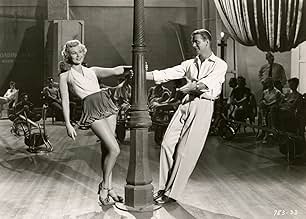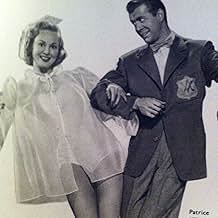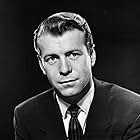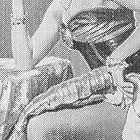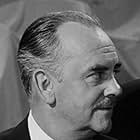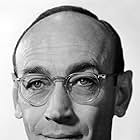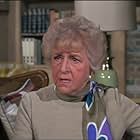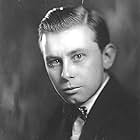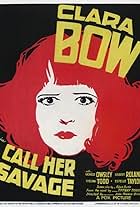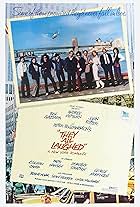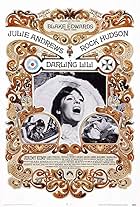VALUTAZIONE IMDb
5,9/10
271
LA TUA VALUTAZIONE
Aggiungi una trama nella tua linguaAfter her Hollywood career fails, an actress returns to Broadway and tries for a comeback in a stage show directed by her former lover.After her Hollywood career fails, an actress returns to Broadway and tries for a comeback in a stage show directed by her former lover.After her Hollywood career fails, an actress returns to Broadway and tries for a comeback in a stage show directed by her former lover.
- Regia
- Sceneggiatura
- Star
Nedrick Young
- Rafferty
- (as Ned Young)
Jacqueline deWit
- Lisa Kramer
- (as Jacqueline de Wit)
Percy Helton
- News Vendor
- (scene tagliate)
Trama
Lo sapevi?
- QuizAbout 11 minutes in, the sadly untalented auditionee is offered a job as a "gofer", one of the earliest documented uses of the word in this sense. The meaning has to be explained to him.
Recensione in evidenza
SHE'S BACK ON Broadway (1953), the sixth and final film to pair actors Virginia Mayo and Steve Cochran, is the first in which their romance takes center stage and the first in which Cochran is something of a good guy. For the record, the others are: WONDER MAN, THE KID FROM BROOKLYN, THE BEST YEARS OF OUR LIVES, A SONG IS BORN and WHITE HEAT and they were romantically involved in all but the first two. This one doesn't quite have the lusty passion of their perilous, ill-fated fling in WHITE HEAT, but the outcome is much more pleasant for both of them (although not nearly as dramatically compelling). It's a different kind of character for Cochran, with a greater degree of emotional vulnerability than we're used to seeing in the tough guy actor. His lingering resentment of Mayo for leaving him six years earlier leads to some pretty obnoxious behavior on his part and I can't say I felt much sympathy for him. Get over it, dude, and get on with the show. In any event, Cochran just doesn't seem suited for the role of a celebrated director of Broadway musicals. He's much too rough-hewn for this rarefied setting. It's a safe bet his character wasn't modeled on George Abbott or Jerome Robbins.
The musical numbers tend to dominate the film, which doesn't leave much room for character development—on either of their parts. The numbers are generally lavish and well-staged and we get to see the two female leads, Mayo and Patrice Wymore, dance a lot, always a treat in my book. And we also get to see Gene Nelson perform in several numbers. However, we never get any sense of what the show they're rehearsing, "Breakfast in Bed," is about or how the numbers connect to each other. Each song seems like it came from a completely different show. There's a number about a New York working girl dreaming of getting rich and in the next one she's a dancer in New Orleans' Mardi Gras celebration. Contrast this with Vincente Minnelli's THE BANDWAGON, also 1953, in which the conception of the musical-within-the-movie is made very clear to us as are the reasons for its flopping, followed by a completely revamped show and a full explanation of why all the numbers are so different from each other. It all made sense there. This film has its pleasures, but it's no BANDWAGON. I must confess, though, that I did like the montage of singing and dancing auditions. It was clearly meant to be funny and the unrealistic, almost surreal quality of it was, I believe, intentional. I enjoyed the kid who keeps returning to audition in each category before they give him a job as a "gopher" to keep him from returning to the auditions. With his skinny frame, gray checked suit and bow tie, he reminded me of Pee Wee Herman and made me wonder if Herman had seen this film as a child. (I'm not sure I heard the character's name, but I'm guessing he's Mickey Zealand, played by Ray Kyle.) Also, the varied songs in the audition sequence, mostly taken from the Warner Bros. song library, look forward to the use of songs in Chuck Jones' classic 1956 cartoon, "One Froggy Evening," another Warner Bros. production.
Mayo is gorgeous in this and always an exciting, scintillating presence, but I was especially taken with Wymore, who was a little more demure and more clearly devoted to Cochran. I was kind of rooting for her and hoping he'd come to his senses. I was more than a little annoyed that Cochran was the third-billed of the male actors even though he has a bigger and more central part than either Nelson, who's billed right after Mayo, and Frank Lovejoy, who plays the producer. I mean, he IS the male lead and has as much screen time as Mayo. I'm posting this on May 25, 2017, which marks the centennial of Cochran's birth.
The musical numbers tend to dominate the film, which doesn't leave much room for character development—on either of their parts. The numbers are generally lavish and well-staged and we get to see the two female leads, Mayo and Patrice Wymore, dance a lot, always a treat in my book. And we also get to see Gene Nelson perform in several numbers. However, we never get any sense of what the show they're rehearsing, "Breakfast in Bed," is about or how the numbers connect to each other. Each song seems like it came from a completely different show. There's a number about a New York working girl dreaming of getting rich and in the next one she's a dancer in New Orleans' Mardi Gras celebration. Contrast this with Vincente Minnelli's THE BANDWAGON, also 1953, in which the conception of the musical-within-the-movie is made very clear to us as are the reasons for its flopping, followed by a completely revamped show and a full explanation of why all the numbers are so different from each other. It all made sense there. This film has its pleasures, but it's no BANDWAGON. I must confess, though, that I did like the montage of singing and dancing auditions. It was clearly meant to be funny and the unrealistic, almost surreal quality of it was, I believe, intentional. I enjoyed the kid who keeps returning to audition in each category before they give him a job as a "gopher" to keep him from returning to the auditions. With his skinny frame, gray checked suit and bow tie, he reminded me of Pee Wee Herman and made me wonder if Herman had seen this film as a child. (I'm not sure I heard the character's name, but I'm guessing he's Mickey Zealand, played by Ray Kyle.) Also, the varied songs in the audition sequence, mostly taken from the Warner Bros. song library, look forward to the use of songs in Chuck Jones' classic 1956 cartoon, "One Froggy Evening," another Warner Bros. production.
Mayo is gorgeous in this and always an exciting, scintillating presence, but I was especially taken with Wymore, who was a little more demure and more clearly devoted to Cochran. I was kind of rooting for her and hoping he'd come to his senses. I was more than a little annoyed that Cochran was the third-billed of the male actors even though he has a bigger and more central part than either Nelson, who's billed right after Mayo, and Frank Lovejoy, who plays the producer. I mean, he IS the male lead and has as much screen time as Mayo. I'm posting this on May 25, 2017, which marks the centennial of Cochran's birth.
- BrianDanaCamp
- 24 mag 2017
- Permalink
I più visti
Accedi per valutare e creare un elenco di titoli salvati per ottenere consigli personalizzati
Dettagli
- Data di uscita
- Paese di origine
- Lingua
- Celebre anche come
- She's Back on Broadway
- Luoghi delle riprese
- 9641 Sunset Boulevard, Beverly Hills, California, Stati Uniti(The Beverly Hills Hotel at beginning of film)
- Aziende produttrici
- Vedi altri crediti dell’azienda su IMDbPro
- Tempo di esecuzione1 ora 35 minuti
- Proporzioni
- 1.33 : 1
Contribuisci a questa pagina
Suggerisci una modifica o aggiungi i contenuti mancanti

Divario superiore
By what name was Virginia dieci in amore (1953) officially released in India in English?
Rispondi

